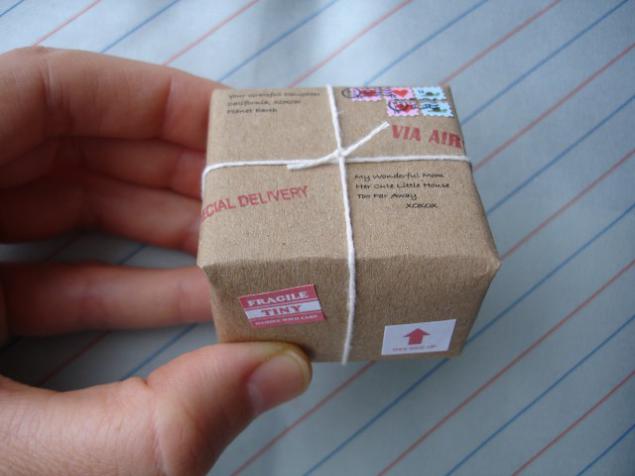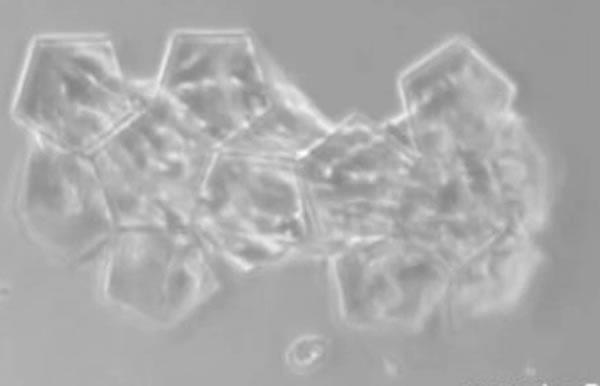819
10 most microscopic things of all, ever created
Malym1 satisfied. Microscopic snegovikV 2009, scientists have created the world's smallest snowman - the size of about one-fifth the width of human hair. Experts from the National Physical Laboratory in West London did a miniature figure of value to 0, 01 mm in cross-section. This masterpiece was assembled with the help of tools for manipulating nanoparticles.

Snowman consists of two small beads of tin, which were welded together with platinum - typically they are used to calibrate the electron microscope lens. Focused ion beam helped make eyes and a smile and a snowman add a tiny drop of platinum for the nose. This is the handiwork of a member of a group of laboratory detection of quantum particles Dr. David Cox, who also took a picture of a snowman.
2. The smallest sculpture mireV April 2015 artist Jonty Hurwitz created the smallest statue in the world. Creation Hurwitz so small that they can relax on human hair on the head of an ant or the same size.
Sculpture of less than 1 mm in height produced by a process called nanozhivopisyu. They are too small to be visible to the naked eye. Consider them only under a microscope or photographs. Mr. Horowitz used in the production of 3D-printing technology.
Spending a few months to work on the fragments, he invited the 45-year-old photographer from Chichester (West Sussex) to capture a photo sculpture on a microscope. Unfortunately, after a few minutes of work Hurwitz photo session was destroyed by accidental blow finger technique out of the laboratory.
3. Tiny Bibliya
This will be difficult to read the Bible, but this is not important. Russell Berry, a researcher at the institute of nanotechnology in Israel, engraved Hebrew Bible on a chip the size of a grain of sugar, in order to demonstrate the extent to which you can work. "Nanobibliya" is written in an ultrathin silicon wafer with thickness less than 100 atoms, a gold-coated. For engraving Hebrew letters, the researchers used is the same focused ion beam, cutting them unnecessary layers of gold. Combining modern technology and ancient techniques, the team called the engraving process chip "poetic beauty". Nanobibliya exhibited in the Shrine of the Book at the Israel Museum.
4. Racing mikromobil
This microscopic car width of only 100 micrometers was built by scientists Vienna University of Technology with nano-sized 3D-printer in 2012. As in the conventional 3D-printer, for shaping a resin so that it solidifies and, a laser.
5. Small MyslitelV 2007 Korean scientists using lasers created a microscopic version of the famous sculpture "The Thinker," which Rodin finished in 1880

Size Mikromyslitelya height of 20 millionths of a meter approximately two times more red blood cells. On a tiny model visible fingers and even muscles.
6. Miniature mail sluzhbaEsli you choose something to surprise their loved ones and believe that great things can come in small packages, then you will want to take advantage of the smallest postal service in the world. It was created in San Francisco postmaster Leia Redmond, who has decided to implement an ambitious idea into practice.

She just put a small desk into his backpack and jumped on the bike and hosted a post office in one of the local cafes. Leah immediately charmed everyone with his miniature-mail.

In the smallest of the world postal service your letters are written with microscopic letters, carefully packaged and sealed tiny seal with the initials of the sender. To little messages do not get lost in the traditional mail, Lea packs them in transparent envelopes with a magnifying glass to identify the mailing address.

7. Less than kinoEto not a joke, this movie is really created by the movement of single atoms around and photographed with a huge microscope.
IBM is exploring new possibilities of atomic-scale memory. Soon it will be possible to press the play button and meet the boy who made friends with the atom.
8. 3D-sculpture byka
In 2001, a group of Japanese engineers have created a small monument to the three-dimensional bull the size of a red blood cell. His engraved plastic engineers Osaka University in Japan.
The size of the sculpture only 10 by 7 micrometers (one micrometer - is one thousandth of a millimeter). The bull is the smallest of the three-dimensional sculpture ever created.
9. Small ekspressKroshechny, only 3 175 mm 6 35 mm, this train - a work of engineering art. Five carriages that 35 to 200 times smaller than the real train, followed by the oval route and even pass through a tunnel 19 mm path.

David Smith, a railway enthusiast from New Jersey, has created this train conventional craft knife and his firm hand.
The train runs on a standard rotary engine length 51 mm, which he cut from the molding of plastic. David took just over 6 pounds (455 rubles), to make their model trains.
10. Microscopic origamiSёdzi Takeuchi and his colleagues at the University of Tokyo have raised the art of origami to new heights. The team succeeded in creating microscopic folds origami, using tissue culture of living cells.

They have created a flat origami design, cutting thin plastic sheets, then grew the cells that are filled with tiny stitches plates. Early studies used animal connective tissue cells (which tend to help heal wounds) to make flexible samples. Later they began to use a rat heart cells. Takeuchi and his colleagues hope that this process will ultimately help create artificial blood vessels and other body tissues.
via www.oddee.com/item_99316.aspx

Snowman consists of two small beads of tin, which were welded together with platinum - typically they are used to calibrate the electron microscope lens. Focused ion beam helped make eyes and a smile and a snowman add a tiny drop of platinum for the nose. This is the handiwork of a member of a group of laboratory detection of quantum particles Dr. David Cox, who also took a picture of a snowman.
2. The smallest sculpture mireV April 2015 artist Jonty Hurwitz created the smallest statue in the world. Creation Hurwitz so small that they can relax on human hair on the head of an ant or the same size.
Sculpture of less than 1 mm in height produced by a process called nanozhivopisyu. They are too small to be visible to the naked eye. Consider them only under a microscope or photographs. Mr. Horowitz used in the production of 3D-printing technology.
Spending a few months to work on the fragments, he invited the 45-year-old photographer from Chichester (West Sussex) to capture a photo sculpture on a microscope. Unfortunately, after a few minutes of work Hurwitz photo session was destroyed by accidental blow finger technique out of the laboratory.
3. Tiny Bibliya

This will be difficult to read the Bible, but this is not important. Russell Berry, a researcher at the institute of nanotechnology in Israel, engraved Hebrew Bible on a chip the size of a grain of sugar, in order to demonstrate the extent to which you can work. "Nanobibliya" is written in an ultrathin silicon wafer with thickness less than 100 atoms, a gold-coated. For engraving Hebrew letters, the researchers used is the same focused ion beam, cutting them unnecessary layers of gold. Combining modern technology and ancient techniques, the team called the engraving process chip "poetic beauty". Nanobibliya exhibited in the Shrine of the Book at the Israel Museum.
4. Racing mikromobil

This microscopic car width of only 100 micrometers was built by scientists Vienna University of Technology with nano-sized 3D-printer in 2012. As in the conventional 3D-printer, for shaping a resin so that it solidifies and, a laser.
5. Small MyslitelV 2007 Korean scientists using lasers created a microscopic version of the famous sculpture "The Thinker," which Rodin finished in 1880

Size Mikromyslitelya height of 20 millionths of a meter approximately two times more red blood cells. On a tiny model visible fingers and even muscles.
6. Miniature mail sluzhbaEsli you choose something to surprise their loved ones and believe that great things can come in small packages, then you will want to take advantage of the smallest postal service in the world. It was created in San Francisco postmaster Leia Redmond, who has decided to implement an ambitious idea into practice.

She just put a small desk into his backpack and jumped on the bike and hosted a post office in one of the local cafes. Leah immediately charmed everyone with his miniature-mail.

In the smallest of the world postal service your letters are written with microscopic letters, carefully packaged and sealed tiny seal with the initials of the sender. To little messages do not get lost in the traditional mail, Lea packs them in transparent envelopes with a magnifying glass to identify the mailing address.

7. Less than kinoEto not a joke, this movie is really created by the movement of single atoms around and photographed with a huge microscope.
IBM is exploring new possibilities of atomic-scale memory. Soon it will be possible to press the play button and meet the boy who made friends with the atom.
8. 3D-sculpture byka

In 2001, a group of Japanese engineers have created a small monument to the three-dimensional bull the size of a red blood cell. His engraved plastic engineers Osaka University in Japan.
The size of the sculpture only 10 by 7 micrometers (one micrometer - is one thousandth of a millimeter). The bull is the smallest of the three-dimensional sculpture ever created.
9. Small ekspressKroshechny, only 3 175 mm 6 35 mm, this train - a work of engineering art. Five carriages that 35 to 200 times smaller than the real train, followed by the oval route and even pass through a tunnel 19 mm path.

David Smith, a railway enthusiast from New Jersey, has created this train conventional craft knife and his firm hand.
The train runs on a standard rotary engine length 51 mm, which he cut from the molding of plastic. David took just over 6 pounds (455 rubles), to make their model trains.
10. Microscopic origamiSёdzi Takeuchi and his colleagues at the University of Tokyo have raised the art of origami to new heights. The team succeeded in creating microscopic folds origami, using tissue culture of living cells.

They have created a flat origami design, cutting thin plastic sheets, then grew the cells that are filled with tiny stitches plates. Early studies used animal connective tissue cells (which tend to help heal wounds) to make flexible samples. Later they began to use a rat heart cells. Takeuchi and his colleagues hope that this process will ultimately help create artificial blood vessels and other body tissues.
via www.oddee.com/item_99316.aspx























